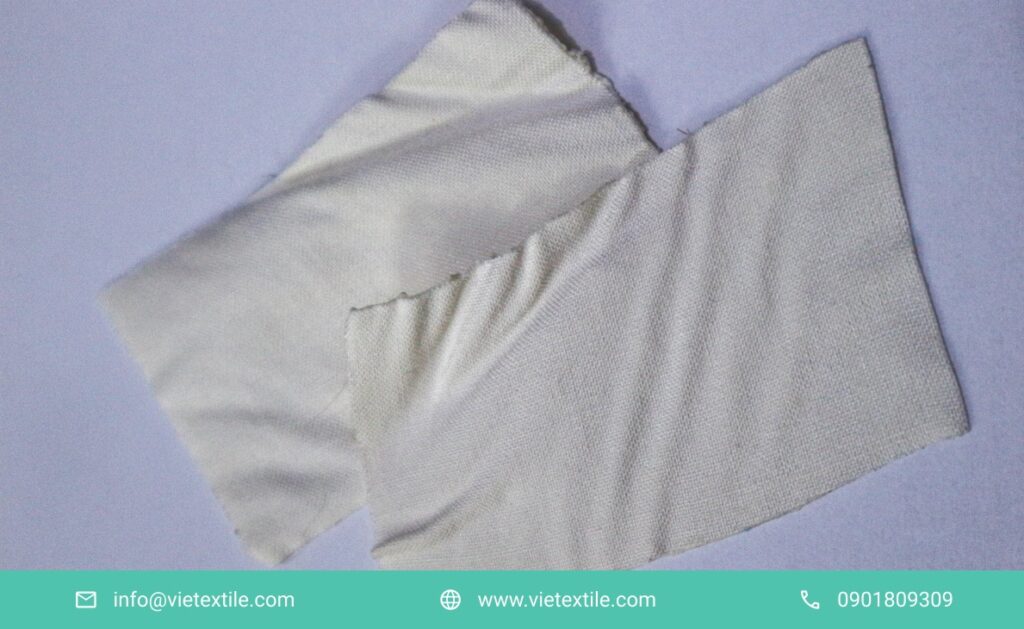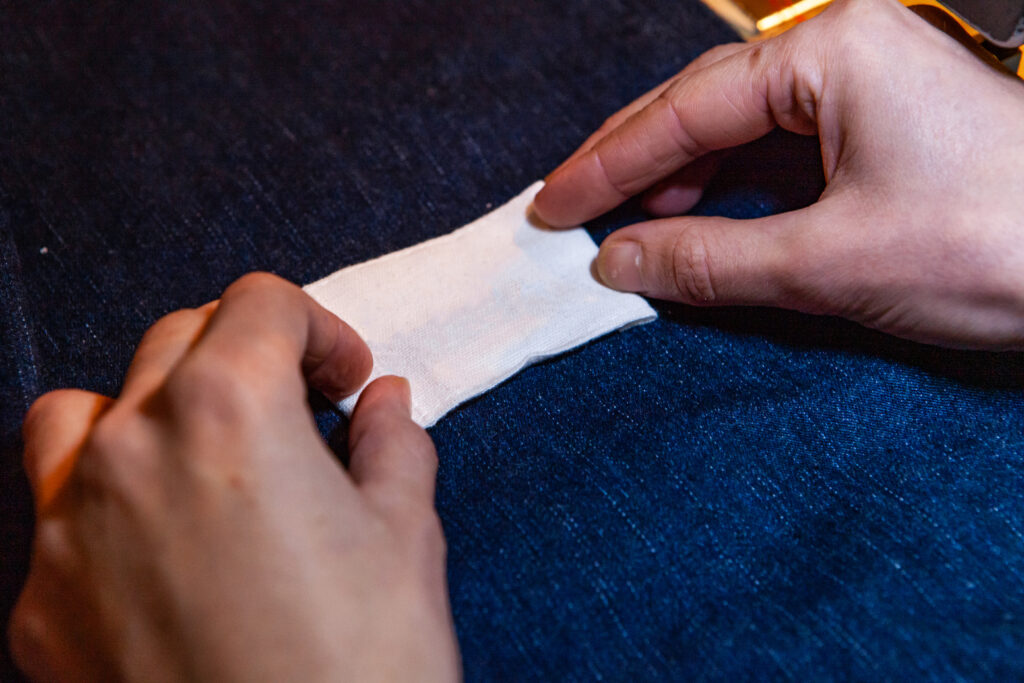A fabric shrinkage processing machine is crucial equipment in the fabric finishing process, helping to stabilize dimensions, prevent shrinkage after washing, and ensure finished product quality. However, if operated incorrectly or not maintained periodically, the equipment can encounter serious errors, affecting fabric quality, incurring costs, and disrupting production.
Below are the 5 most common errors when using a fabric shrinkage processing machine, their causes, and specific solutions.
1. Uneven Fabric Shrinkage
Nội dung tóm tắt
Toggle
This is one of the most common errors when operating a fabric shrinkage processing machine in a textile factory. When the equipment is not set up correctly or deviates during operation, the fabric may shrink unevenly across different areas or directions. This not only affects the quality of the finished product but also causes difficulties in subsequent processing stages. Therefore, early identification of causes and effective solutions are crucial for any unit using a fabric shrinkage processing machine.
1.1. Causes:
Error 1: Incorrect Fabric Tension Upon Entry
When feeding fabric into the fabric shrinkage processing machine, if the tension is not adjusted properly or the fiber direction is not aligned correctly, the fabric will be skewed, leading to uneven shrinkage. This is a very common error in workshops without automatic selvedge guiding and tension adjustment systems.
Error 2: Inconsistent Pressure or Temperature Between Processing Zones
During the operation of the fabric shrinkage processing machine, if the parameters in the processing zones (pre-heating, steaming, cooling) are unstable or inconsistent, the fabric will shrink unevenly in width and length. This greatly affects the dimensional stability and aesthetic appeal of the finished product.
Error 3: Humidifying or Cooling Units Operating Unstably
Some fabric shrinkage processing machines are not maintained periodically, causing the humidifying or cooling units to perform poorly, leading to fabric stiffness, distorted edges, or failure to achieve standard softness. Regular inspection of steam spray valves, water pumps, and cooling systems is necessary to ensure smooth operation.
1.2. Solutions for Uneven Fabric Shrinkage Caused by the Fabric Shrinkage Processing Machine
Solution 1: Check and Adjust Tension
Before feeding into the fabric shrinkage processing machine, ensure the input fabric tensioning system operates accurately. Adjusting the appropriate tension and ensuring the nip rollers do not create uneven force between the two fabric edges will help the fabric be processed uniformly.
Solution 2: Stabilize Temperature and Pressure Parameters
During the operation of the fabric shrinkage processing machine, ensure that parameters such as temperature and pressure between the pre-heating, steaming, and cooling zones are always balanced and uniform. This prevents the fabric from shrinking unevenly in width or length.
Solution 3: Maintain Humidifying and Cooling Systems
One of the causes of uneven shrinkage is due to the humidifying or cooling units not functioning correctly. Therefore, schedule regular maintenance for these components in the fabric shrinkage processing machine to ensure the entire process runs stably and efficiently.
➡️ When the fabric shrinkage processing machine operates stably, the fabric will maintain its flatness and standard dimensions after washing.
2. Fabric Edge Burning or Shininess
When operating a fabric shrinkage processing machine, one of the most serious and damaging errors is fabric edge burning or shininess. This error not only reduces aesthetic appeal but also causes the fabric to fail technical requirements, leading to material waste and increased production costs. Especially with heat-sensitive materials like polyester, if technical parameters are not well-controlled during processing, edge burning is very likely to occur. Therefore, understanding the causes and solutions when using a fabric shrinkage processing machine is essential to ensure material safety and production efficiency.
2.1. Causes:
Error 1: Excessive Drying Temperature or Prolonged Heat Exposure
When using a fabric shrinkage processing machine, if the drying zone temperature is set too high or the fabric’s heat exposure time exceeds the allowable limit, it will lead to edge burning or shininess. This error is particularly dangerous for synthetic fabrics like polyester or nylon, which are sensitive to heat.
Error 2: Nip Rollers are Dirty, Jammed, or Too Tight
During the operation of the fabric shrinkage processing machine, if the nip rollers are not cleaned regularly or are adjusted too tightly, uneven pressure will cause shininess or edge burning on the fabric. The accumulation of impurities on the roller surface also reduces heat transfer efficiency and increases the risk of damaging the fabric surface.
Error 3: Insufficient Cooling After Heat Treatment
Some fabric shrinkage processing machine systems are not equipped with an end-of-line cooling system, or cooling is insufficient, leading to the fabric retaining heat for too long, creating burnt areas or losing softness. Especially when processing continuously at high speeds, insufficient cooling is more likely to cause serious errors.
2.2. Solutions for Fabric Edge Burning or Shininess Caused by the Fabric Shrinkage Processing Machine
Solution 1: Reduce Temperature and Adjust Fabric Speed
Upon detecting signs of edge burning, immediately reduce the drying temperature in the fabric shrinkage processing machine to a safe level suitable for the fabric material. Simultaneously, slow down the fabric speed to reduce heat exposure time and prevent the burn from spreading.
Solution 2: Regular Roller Cleaning, Check Nip Pressure
Overly tight or dirty rollers cause uneven heat transfer, leading to shininess or localized burning. Schedule regular cleaning and check the nip pressure of the rollers in the fabric shrinkage processing machine to ensure the contact surface is always clean and the pressure is correct.
Solution 3: Supplement with an Efficient Cooling System
Install or upgrade the cooling unit after the heating zone in the fabric shrinkage processing machine, helping the fabric cool down quickly after exposure to high temperatures, preventing continued heat retention that causes fabric burning after processing.
➡️ Correctly adjusting heat parameters is vital when using a fabric shrinkage processing machine with flammable materials like polyester or nylon.
3. Wrinkled or Wavy Fabric After Processing

One of the common errors when using a fabric shrinkage processing machine is fabric wrinkling or unwanted waves appearing after finishing. This error can stem from inaccurate fabric feeding, uneven tension, or inappropriate moisture content. If not addressed promptly, the fabric will lose its necessary flatness and affect subsequent processing capabilities.
3.1. Causes:
Error 1: Fabric Skewing When Fed into the Fabric Shrinkage Processing Machine
During the process of feeding fabric into the fabric shrinkage processing machine, if there is no centering system or manual operation is inaccurate, the fabric’s fiber direction will be skewed, leading to wrinkling or waviness after processing. This is a very common error in workshops that are not fully automated.
Error 2: Insufficient Tension at the Beginning and End of the Processing Line
One of the reasons why fabric is not completely flattened is due to insufficient or uneven tension between the input and output of the fabric shrinkage processing machine. This causes the fabric to sag or contract when passing through the heating and cooling zones, creating wrinkles or noticeable waves on the surface.
Error 3: Inappropriate Fabric Moisture Content Before Processing
If the fabric is too dry or too wet when entering the fabric shrinkage processing machine, it will directly affect the fiber’s ability to set and flatten the surface. Substandard moisture content causes uneven heat transfer, leading to unwanted fabric shrinkage and the appearance of waves.
3.2. Solutions:
Solution 1: Use Automatic Tensioning Machine and Centering Sensor
An automatic tensioning system combined with a centering sensor helps the fabric be fed into the fabric shrinkage processing machine in the correct direction, without edge deviation. This solution is particularly effective in limiting creases and fabric waves from the very beginning, setting the stage for a stable processing.
Solution 2: Increase Uniform Tension at Both Ends of the Machine
Ensure that the input and output tensions of the fabric shrinkage processing machine are adjusted uniformly. Balancing the tension helps the fabric spread evenly, preventing sagging or contraction, thereby minimizing wrinkling or waviness after heat treatment and cooling.
Solution 3: Adjust Humidifying Machine for Even Fabric Softening Before Processing
Before entering the heating zone of the fabric shrinkage processing machine, ensure the fabric is evenly humidified using a misting system or softening chamber. Appropriate moisture helps fabric fibers expand better during processing, reducing creasing and improving surface flatness.
➡️ For the fabric shrinkage processing machine to achieve maximum efficiency, the fabric’s physical condition must be optimized from the very beginning.
4. High Power Consumption, Unstable Operation
During the use of a fabric shrinkage processing machine, excessive power consumption or unstable equipment operation is a problem that causes headaches for many businesses. These errors not only increase operating costs but also lead to production interruptions and reduced machine lifespan if not addressed promptly.
4.1. Causes:
Error 1: Degraded Heating System, Motor, or Inverter
When components such as the heating system, motor, or inverter in the fabric shrinkage processing machine operate inefficiently due to degradation over time, the equipment will consume more power and struggle to maintain stable operation. This is a primary cause of energy waste and reduced processing efficiency.
Error 2: Machine Overloading, Lack of Maintenance
If the fabric shrinkage processing machine continuously operates beyond its designed capacity or is not maintained periodically, components will quickly break down. This situation not only affects the machine’s durability but also leads to sudden operational errors, impacting production schedules.
Error 3: Sensor Malfunction, Inaccurate Control
Sensors in the fabric shrinkage processing machine control parameters such as temperature, pressure, and speed. When sensors malfunction or send inaccurate signals to the control system, the machine may process in the wrong mode, leading to product errors and unintended energy consumption.
4.2. Solutions for Unstable Operation of the Fabric Shrinkage Processing Machine
Solution 1: Check Thermal Resistors and Replace Faulty Motors
The heating system and motor are major power consumers in the fabric shrinkage processing machine. If experiencing power overload or weak machine operation, check thermal resistors, inverters, and replace degraded motors to ensure stable equipment operation.
Solution 2: Schedule Regular Maintenance
To ensure the fabric shrinkage processing machine always operates stably, a specific maintenance plan should be established periodically (weekly, monthly, quarterly). Avoid continuous overloading of the machine as this will reduce equipment lifespan and increase operating costs.
Solution 3: Calibrate Sensors and Control Parameters
In many cases, abnormal power consumption is due to sensor deviation, or inaccurate input signals. It is necessary to check and recalibrate all sensors and reprogram control parameters suitable for each fabric type processed in the fabric shrinkage processing machine.
5. Fabric Discoloration or Color Bleeding After Processing

Some factories using a fabric shrinkage processing machine have encountered issues where the fabric discolors or bleeds unexpectedly after processing. This error is related to the combination of temperature, humidity, and water quality during the processing. If not well-controlled, the finished product will lose uniformity and fail to meet quality requirements.
5.1. Causes:
Error 1: Excessive Heat Causing Dye Degradation
During the use of the fabric shrinkage processing machine, if the drying zone temperature is set too high, the dye on the fabric surface will degrade, causing color changes or a burnt color effect. This error is common when processing fabrics dyed with heat-sensitive dyes.
Error 2: Fabric Not Completely Dry Before Entering the Machine
If wet or partially dried fabric is fed into the fabric shrinkage processing machine, residual moisture will react with the dye under heat, causing color bleeding. This situation often occurs in lines without a pre-drying or dewatering step before shrinkage processing.
Error 3: Steam Containing Impurities Affecting Color
If the steam system in the fabric shrinkage processing machine uses water that is not thoroughly filtered or contains minerals, chemical impurities, it can react with the dye, causing surface discoloration or reducing color brightness. This error is very common in workshops using industrial water that does not meet standards.
5.2. Solutions for Fabric Discoloration or Color Bleeding After Processing
Solution 1: Lower Drying Zone Temperature and Ensure Uniform Heat
When processing highly color-sensitive fabrics, the drying zone temperature in the fabric shrinkage processing machine should be reduced. Simultaneously, ensure the heat distribution system is uniform across the entire fabric surface to prevent color bleeding or localized burning.
Solution 2: Pre-dry Fabric or Dewater Before Shrinkage Processing
If the fabric is still wet or not uniformly dry, the dye will easily disperse unevenly under heat. Therefore, pre-dry or dewater the fabric to achieve ideal moisture content before feeding it into the fabric shrinkage processing machine, helping colors stabilize and become more uniform.
Solution 3: Use Standard Processing Water Source
Steam containing many impurities will react with the dye and cause color bleeding. Ensure that the water supply and steam in the fabric shrinkage processing machine are thoroughly filtered and meet industrial standards to protect fabric color as well as the equipment system.
➡️ In dyeing lines, the fabric shrinkage processing machine needs to be closely integrated with preceding and succeeding stages to avoid color errors.
6. Conclusion: Sustainable Solutions for Operating a Fabric Shrinkage Processing Machine
Operating a fabric shrinkage processing machine not only requires quality equipment but also demands strict process control skills from input to output. A small operational error – whether in temperature, humidity, or tension – can lead to significant consequences such as uneven shrinkage, edge burning, fabric wrinkling, or discoloration. These errors not only affect fabric quality but also significantly increase production costs.
To achieve optimal performance when using a fabric shrinkage processing machine, businesses need to continuously review their systems, perform periodic maintenance, and enhance the capabilities of their technical team. When equipment and personnel work in sync, you will maintain stable product quality, minimize technical errors, and increase your competitive advantage in the increasingly demanding textile industry.
7. References & Contact
Internal References:
- Fabric Setting Machine: Improving Durability, Enhancing Fabric Quality
- Textile Dyeing Production Process: Detailed Steps and Practical Applications
- Common Finishing Machine Issues
- Common Practices Followed to Control Fabric Shrinkage in Garment Manufacturing
Need advice on selecting and operating an efficient fabric shrinkage processing machine? Contact VieTextile now for comprehensive technical support and real-world demos.
- Hotline: 0901 809 309
- Email: info@vietextile.com
- Website: https://vietextile.com










